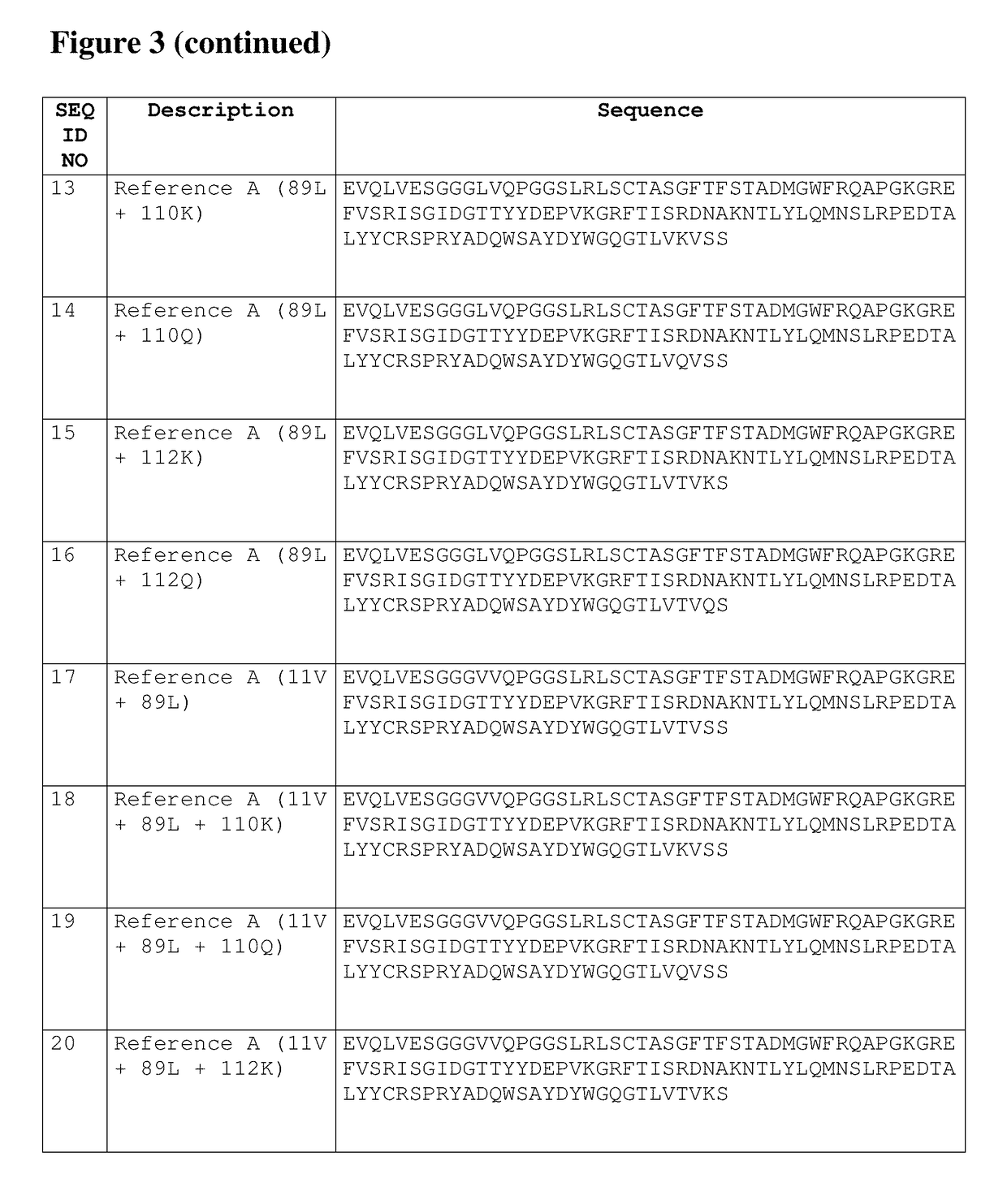TNF binders
a technology of tnf and binders, which is applied in the field of tnf binders, can solve the problems of increased infection risk, loss of patient compliance, undesirable long-term side effects, opportunistic infections, etc., and achieves the effect of enhancing the stability of tnf binders and increasing the stability of gastric degradation
- Summary
- Abstract
- Description
- Claims
- Application Information
AI Technical Summary
Benefits of technology
Problems solved by technology
Method used
Image
Examples
example 2
[0449]The protein sequences of the TNF-binders of the present invention were eventually retrieved from llamas and are partially distinct from homologous antibodies occurring naturally in humans. Therefore, these TNF-binders are potentially immunogenic when administered to human patients.
[0450]Generally, for humanization purposes the Nanobody sequences are made more homologous to human germline consensus sequence. With the exception of the Nanobody “hallmark” residues, specific amino acids in the framework regions that differ between the Nanobody and a human germline consensus sequence are altered to the human counterpart in such a way that the protein structure, activity and stability are preferably kept intact.
[0451]In this case, after an alignment with the human germline V gene database, DP51 was identified as having the highest homology with SEQ ID NO: 58. All possible permutations were elaborated in view of altering the parental Nanobody sequence more conform to the human DP5...
example 3
Binding of Pre-Existing Antibodies
[0453]3.1 Experimental Part
[0454]The human samples used in Example 3.2 below were either obtained from commercial sources or from human volunteers (after all required consents and approvals were obtained) and were used in according with the applicable legal and regulatory requirements (including but not limited to those regarding medical secret and patient privacy).
[0455]In Example 3.2 below, unless explicitly indicated otherwise, the binding of pre-existing antibodies that are present in the samples used (i.e. from healthy volunteers, rheumatoid arthritis (RA) patients and SLE patients) to the Nanobodies tested was determined using ProteOn as follows:
[0456]Nanobodies were captured either on serum albumin or via a FLAG3 tag using monoclonal anti-FLAG M2.
[0457]In case of binding of pre-existing antibodies on Nanobodies captured on human serum albumin (HSA) was evaluated using the ProteOn XPR36 (Bio-Rad Laboratories, Inc.). PBS / Tween (phosphate buffer...
example 4
[0463]The chemical stability of the various humanized and / or optimized Nanobodies were assessed via forced oxidation and temperature stress tests.
[0464]A new reference compound was made, i.e. A016600015 (SEQ ID NO: 61). This new reference compound is more conform to presumed clinical candidates, and thus enables a better assessment of the impact of mutations. A016600015 is identical to Reference A (SEQ ID NO: 1) except for a C-terminal Alanine and an Aspartate at amino acid residue 1. The C-terminal Ala was introduced in view of reducing PEAs according to WO 2012 / 175741 (cf. Example 3). The N-terminal Glutamate was substituted for an Aspartate at amino acid residue 1 after an assessment of pyroglutamate formation. The activity of the new reference A016600015 was virtually identical to Reference A (data not shown). This new compound A016600015 is further used throughout the examples as the reference compound unless indicated otherwise.
[0465]Based on the results of...
PUM
| Property | Measurement | Unit |
|---|---|---|
| weight | aaaaa | aaaaa |
| weight | aaaaa | aaaaa |
| flow rate | aaaaa | aaaaa |
Abstract
Description
Claims
Application Information
 Login to View More
Login to View More - R&D
- Intellectual Property
- Life Sciences
- Materials
- Tech Scout
- Unparalleled Data Quality
- Higher Quality Content
- 60% Fewer Hallucinations
Browse by: Latest US Patents, China's latest patents, Technical Efficacy Thesaurus, Application Domain, Technology Topic, Popular Technical Reports.
© 2025 PatSnap. All rights reserved.Legal|Privacy policy|Modern Slavery Act Transparency Statement|Sitemap|About US| Contact US: help@patsnap.com



